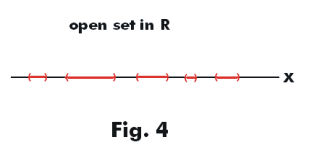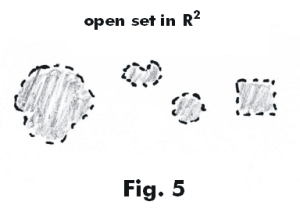
Website owner: James Miller
Bases, subbases for a topology. Subspaces. Relative topologies.
Def. Base for a topology. Let (X, τ) be a topological space. A class B of open sets is a base for the topology of X if each open set of X is the union of some of the members of B.
Syn. Basis
Example 1. The open intervals on the real line form a base for the collection of all open sets of real numbers i.e. the usual topology on R.
Example 2. The open discs in the plane form a base for the collection of all open sets in the plane R2 i.e. the usual topology on R2. The open rectangles in the plane also form a base for the collection of all open sets in the plane.

Example 3. Let X represent the open point set shown in Fig. 1 with a topology τ consisting of all open sets in X. The open spheres in space form a base for topology τ. The open rectangular parallelepipeds in space also form a base for τ.
Example 4. Let X be any discrete space with topology D. Then the collection
B = {{p}: p ε X}
of all singleton subsets of X is a base for the discrete topology D.
What conditions must a collection of subsets meet in order to be a base for some topology of a set X? The answer is given by the following theorem:
Theorem 1. Let B be a collection of subsets of a set X. Then B is a base for some topology on X if and only if it possesses the following two properties:
1) X =
![]() {B: B ε B}
{B: B ε B}
2) For any B, B* ε B, B
![]() B* is the union of members of B,
B* is the union of members of B,
or, equivalently,
if p ε B
![]() B*, then there exist a Bp ε B such
that p ε Bp where Bp is a subset of B
B*, then there exist a Bp ε B such
that p ε Bp where Bp is a subset of B
![]() B*.
B*.
Def. Subbase for a topology. Let (X, τ) be a topological space. A class S of open sets is a subbase for the topology τ on X if the collection of all finite intersections of members of S is a base for the topology.

Example 5. Every open interval (a, b) in the
real line R is the intersection of two infinite open
intervals (a,
![]() ) and (-
) and (-
![]() , b) i.e. (a, b) = (a,
, b) i.e. (a, b) = (a,
![]() )
)
![]() (-
(-
![]() , b). The open intervals form a base for the usual topology on R and the collection of all
of these infinite open intervals is a subbase for the usual topology on R.
, b). The open intervals form a base for the usual topology on R and the collection of all
of these infinite open intervals is a subbase for the usual topology on R.
Example 6. The intersection of a vertical and a horizontal infinite open strip in the plane is an open rectangle as shown in Fig. 2. The open rectangles form a base for the usual topology on R2 and the collection of all infinite open strips (horizontal and vertical) is a subbase for the usual topology on R2.
Topologies generated by collections of sets. Let A be any class of sets of a set X. Although A may not be a base for a topology on X it always generates a topology on X in the following sense:
Theorem 2. Any class A of subsets of a non-empty set X is the subbase for a unique topology T on X. That is, finite intersections of members of A form a base for the topology T on X.
Theorem 3. Let A be a class of subsets of a non-empty set X. Then the topology T on X generated by A is the intersection of all topologies on X which contain A.
Base for the neighborhood system of a point p (or a local base at p). Let p be a point in a topological space X. A collection N of open sets is a base for the neighborhood system of a point p (or a local base at p) if p belongs to each member of N and any open set which contains p also contains a member of N.
Example 7. Consider the collection of all open sets in the plane R2 i.e. the usual topology on R2. Then the collection Bp of all open discs centered at p is a local base at p because any open set K that contains p also contains an open disc Dp whose center is p. See Fig. 3.

Example 8. Consider the collection of all open sets of real numbers i.e. the usual topology on R. The collection of all open intervals (a - δ, a + δ) with center at a is a local base at point a.
Example 9. Let X be any discrete space and let p ε X. Then a local base at point p is the singleton set {p}.
Theorem 4. Let B be a base for a topology T on a topological space X and let p ε X. Then the members of the base B which contain p form a local base at the point p.
Theorem 5. A point p in a topological space X is a limit point of a subset A of X if and only if each member of some local base Bp at p contains a point of A different from p.

Theorem 6. A sequence {a1, a2, ..... } of points in a topological space X converges to p ε X if and only if each member of some local base Bp at p contains almost all, i.e. all but a finite number, of the terms of the sequence.
Subbase for the neighborhood system of a point p (or a local subbase at p). Let p be a point in a topological space X. A subbase for the neighborhood system of a point p (or a local subbase at p) is a collection S of sets such that the collection of all finite intersections of members of S is a base for the neighborhood system of p.
****************************************************************************
Subspaces, relative topologies. Let (X, T) be a topological space. Let A be a subset of X. Then the collection TA of all intersections of A with the open sets of T is a topology on A, called the subspace topology or relative topology on A. The topological space A with topology TA is called a subspace of X. The members of TA are open sets in the sense of the definition of a topological space. They are called open because they form a topology but may not be the same open sets as those of T.
Example 4. Let X be the real line R with the usual topology, the set of all open sets on the real line. An open set on the real line is some collection of open intervals such as that shown in Fig. 4. Let A be some interval [a, b] of the real line. Then the relative topology on [a, b] is the collection TA of all intersections of [a, b] with the set of all open sets of R. The open sets of TA will consist of closed /open sets of type [a, b) and (a, b]. The topological space A with topology TA is a subspace of R.
Example 5. Let X be the plane R2 with the usual topology, the set of all open sets in the plane. An open set in R2 is a set such as that shown in Fig. 5. Let A be the rectangular region in R2 given by

x1
![]() x
x
![]() x2
x2
y1
![]() y
y
![]() y2
y2
Then the relative topology on A is the collection TA of all intersections of A with the set of all open sets of R2. The open sets of TA consist of partially open / partially closed sets. The topological space A with topology TA is a subspace of R2.
When dealing with a space X and a subspace A, one must be careful in using the term “open set”. Does he mean an open set of T or of TA? If A is a subspace of X, we say that a set U is open in A (or open relative to A) if it belongs to TA. We say that U is open in X if it belongs to T.
There is a special situation in which every set open in A is also open in X:
Theorem 7. Let A be a subspace of X. If a set U is open in A and A is open in X, then U is open in X.
Theorem 8. Let A be a subset of X. If B is a base for the topology of X, then the collection
BA = {B
![]() A: B ε B}
A: B ε B}
is a base for the subspace topology on A.
Example 6. Let X be the real line R with the usual topology. Let A = [a, b] be a subset of X. A base B for the usual topology on R is the set of all open intervals (a, b). A base BA for the subspace topology on A is the collection of all intersections of [a, b] with the set of all open intervals (a, b) i.e. a collection of closed /open sets of type [a, b) and (a, b].
References
1. Lipschutz. General Topology
2. Simmons. Introduction to Topology and Modern Analysis
3. Munkres. Topology, A First Course
4. James & James. Mathematics Dictionary
Jesus Christ and His Teachings
Way of enlightenment, wisdom, and understanding
America, a corrupt, depraved, shameless country
On integrity and the lack of it
The test of a person's Christianity is what he is
Ninety five percent of the problems that most people have come from personal foolishness
Liberalism, socialism and the modern welfare state
The desire to harm, a motivation for conduct
On Self-sufficient Country Living, Homesteading
Topically Arranged Proverbs, Precepts, Quotations. Common Sayings. Poor Richard's Almanac.
Theory on the Formation of Character
People are like radio tuners --- they pick out and listen to one wavelength and ignore the rest
Cause of Character Traits --- According to Aristotle
We are what we eat --- living under the discipline of a diet
Avoiding problems and trouble in life
Role of habit in formation of character
Personal attributes of the true Christian
What determines a person's character?
Love of God and love of virtue are closely united
Intellectual disparities among people and the power in good habits
Tools of Satan. Tactics and Tricks used by the Devil.
The Natural Way -- The Unnatural Way
Wisdom, Reason and Virtue are closely related
Knowledge is one thing, wisdom is another
My views on Christianity in America
The most important thing in life is understanding
We are all examples --- for good or for bad
Television --- spiritual poison
The Prime Mover that decides "What We Are"
Where do our outlooks, attitudes and values come from?
Sin is serious business. The punishment for it is real. Hell is real.
Self-imposed discipline and regimentation
Achieving happiness in life --- a matter of the right strategies
Self-control, self-restraint, self-discipline basic to so much in life